Physical Address
304 North Cardinal St.
Dorchester Center, MA 02124
Physical Address
304 North Cardinal St.
Dorchester Center, MA 02124

Outdoors enthusiasts discover twelve budget-friendly preparation secrets that separate safe backcountry adventures from wilderness emergencies that could end everything.
Statistics show that 70% of wilderness emergencies happen to unprepared campers who underestimated backcountry challenges. You don’t need expensive gear or years of experience to camp safely in remote areas, but you’ll need smart preparation that won’t break your budget. The difference between a memorable adventure and a dangerous situation often comes down to twelve essential steps that experienced backpackers follow religiously. These proven strategies will transform your approach to wilderness camping and keep you confident on any trail.
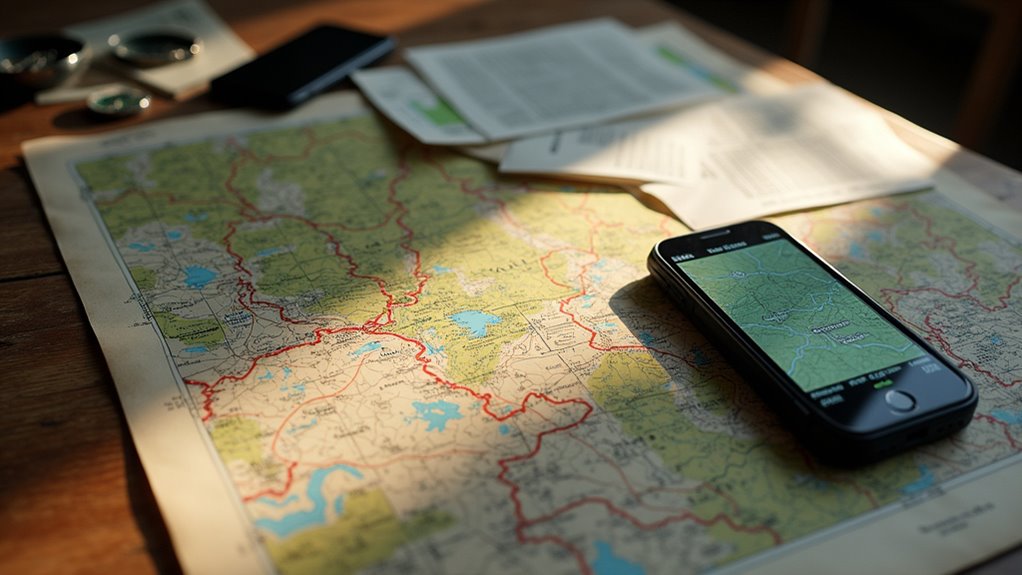
Before you pack a single piece of gear, you’ll want to thoroughly research your chosen destination and current trail conditions. Check the official park or forest service website for recent trail closures, weather alerts, and permit requirements. Don’t forget to verify if you need reservations—many popular spots book months ahead.
Research your destination thoroughly before packing—check official websites for closures, permits, and reservations that book months in advance.
Look up recent trip reports on hiking forums and apps like AllTrails to get real-time updates from other campers. They’ll tell you about washouts, fallen trees, or muddy sections that official sources might miss.
Study topographic maps to identify water sources, camping restrictions, and potential escape routes. Download offline maps to your phone as backup.
Finally, check the weather forecast for both base elevation and higher altitudes, since mountain weather changes rapidly.
Plus, inform someone about your planned route and expected return time, as this essential safety tip can be crucial if you encounter an emergency in the backcountry.
Once you’ve gathered intel on your destination, sketch out your daily hiking distances and camping spots on paper or a mapping app. Don’t overestimate your abilities – plan for 8-12 miles per day max, depending on terrain difficulty and your fitness level. Mark water sources, resupply points, and designated camping areas along your route.
Most importantly, identify multiple emergency exit points throughout your journey. These bailout routes could save your life if weather turns dangerous, someone gets injured, or gear fails. Download offline maps to your phone and carry a paper backup – cell service won’t exist out there.
When scouting potential overnight locations, consider the perfect campsite factors like proximity to water, level ground, wind protection, and Leave No Trace principles to ensure both safety and minimal environmental impact.
Share your detailed itinerary with someone reliable at home, including your planned exit date and emergency contact numbers.
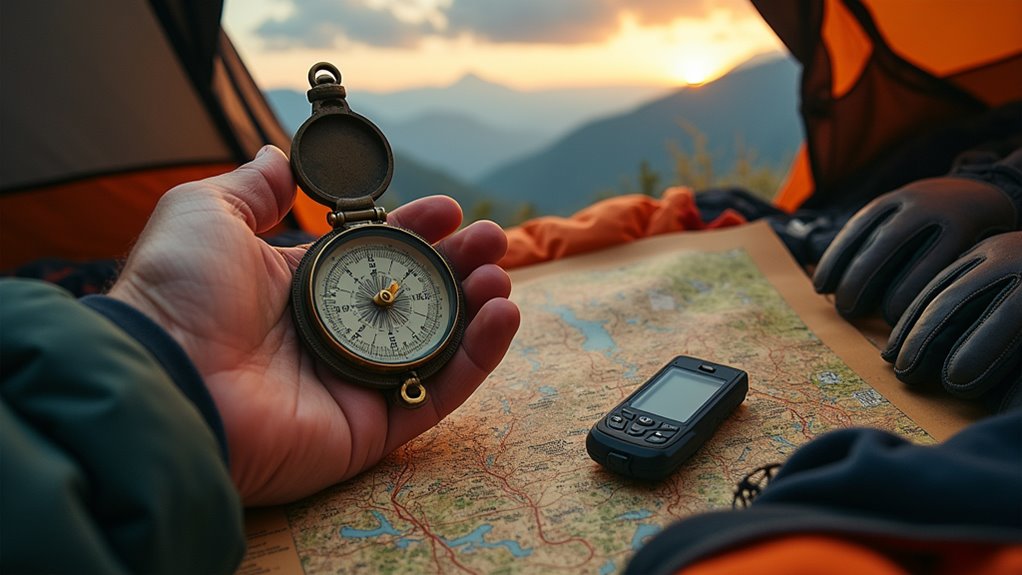
Weather conditions can make or break your backcountry adventure, so you’ll want to check forecasts for your entire trip window plus a few extra days. Mountain weather changes rapidly, and what starts sunny can turn dangerous within hours.
Use multiple free sources like NOAA Weather, Mountain-Forecast.com, and local ranger station updates. Don’t rely on phone apps alone—they’re often inaccurate for remote areas.
Check historical weather patterns for your destination during that time of year to understand typical conditions.
Pay special attention to temperature swings, precipitation chances, and wind speeds. These factors determine what gear you’ll need and whether certain routes remain safe.
If severe weather’s predicted, postpone your trip. It’s cheaper than a rescue operation.
Winter camping presents unique challenges that require extra preparation, so consider additional gear and safety measures for winter RV camping in cold weather conditions.
Since your life depends on staying warm and dry overnight, choosing the right shelter and sleep system becomes your most critical gear decision. You’ll need a tent that handles expected weather conditions without breaking your budget. Three-season tents work for most trips, while four-season models are necessary for winter camping. Don’t forget about weight—ultralight options cost more but save your back.
Your sleep system includes a sleeping bag rated 10-15 degrees below expected nighttime temperatures and a sleeping pad with adequate R-value for insulation from cold ground. Down bags pack smaller but lose warmth when wet, while synthetic fills maintain insulation in damp conditions. Test everything at home first—discovering gear problems in the wilderness isn’t fun.
For those planning backpacking adventures across regions like the UK, consider how different climates and terrains might affect your shelter choices throughout your journey.
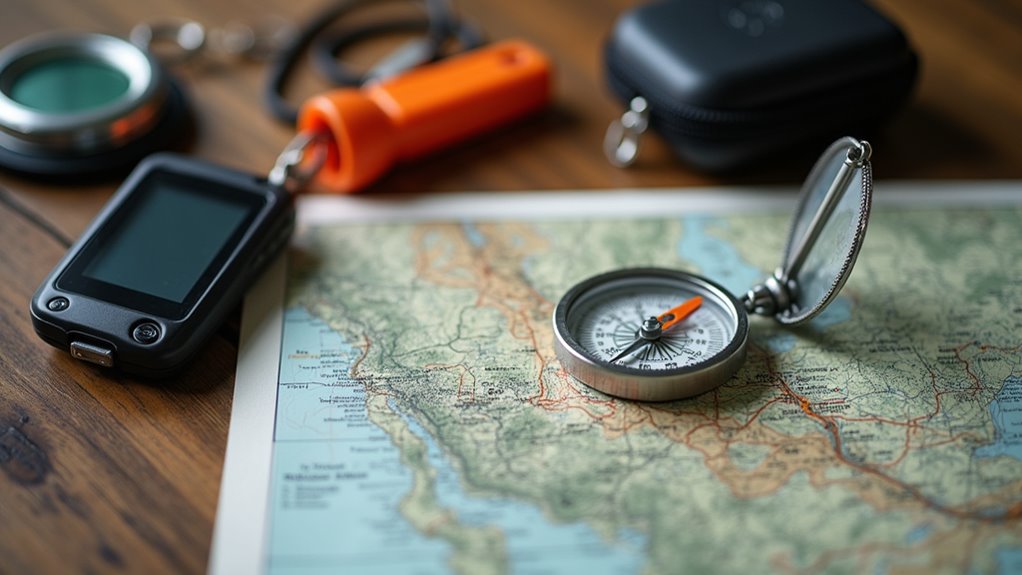
While smartphones offer convenient GPS apps, you can’t stake your life on battery power and cell coverage in remote wilderness areas. You need reliable backup navigation tools that don’t depend on technology.
Start with a quality topographic map of your area and a basic compass. Learn to use them before you leave home – practice triangulation and bearing techniques in familiar territory.
Consider these essential backup options:
Don’t forget to tell someone your planned route and expected return time. The cheapest navigation tool is prevention – letting others know where you’re headed keeps search teams from looking in wrong places.
Just like choosing between renting or buying a boat for fishing trips, weigh the costs and frequency of use when investing in high-end navigation equipment.
Unless you’re camping near a guaranteed clean water source, you’ll need multiple methods to purify what you find in the backcountry. Pack at least two purification options as backup—water filter tablets are cheap and lightweight, while a portable pump filter handles larger volumes efficiently.
Bring more water containers than you think you’ll need. Collapsible bottles save pack space when empty. A hydration bladder lets you drink hands-free while hiking. Don’t forget electrolyte packets or tablets to replace what you lose through sweat.
Test your purification methods before departing. Know how long tablets take to work and practice using your filter. Calculate your daily water needs based on activity level, weather, and available sources. Plan refill points along your route. Having the right camping supplies ensures you’re prepared for any water challenges you might encounter in remote locations.

How much food should you pack for three days in the wilderness when you’re burning 3,000+ calories daily? You’ll need approximately 2.5-3 pounds of food per day, totaling 7-9 pounds for your trip.
Focus on calorie-dense, lightweight options that won’t spoil.
Calculate your needs by multiplying days by daily caloric requirements, then select foods providing 125-130 calories per ounce. Dried fruits, nuts, pasta, and instant meals offer excellent nutrition-to-weight ratios without breaking your budget.
Essential meal planning considerations:
Pre-portion everything at home to avoid overpacking and reduce waste on the trail. When selecting your food options, prioritize low impact camping principles by choosing items with minimal packaging and biodegradable ingredients.
When you’re miles from the nearest hospital, a well-stocked first aid kit becomes your lifeline for handling everything from minor cuts to serious injuries. Don’t rely on basic store-bought kits—they’re inadequate for backcountry situations.
A comprehensive first aid kit isn’t optional in remote areas—it’s the difference between managing an emergency and facing disaster.
Include adhesive bandages in various sizes, gauze pads, medical tape, antiseptic wipes, and antibiotic ointment for wound care. Pack pain relievers, antihistamines for allergic reactions, and any personal medications. Add tweezers for splinter removal, scissors, disposable gloves, and a thermometer.
Consider specialized items like elastic bandages for sprains, instant cold packs, and an emergency whistle. Include emergency contact information and basic first aid instructions. Store everything in a waterproof container that’s easily accessible.
Practice using your supplies before departing—knowing how to properly clean wounds or apply bandages could save someone’s life. Remember that essential first aid items are specifically tailored for camping environments where traditional medical help isn’t readily available.
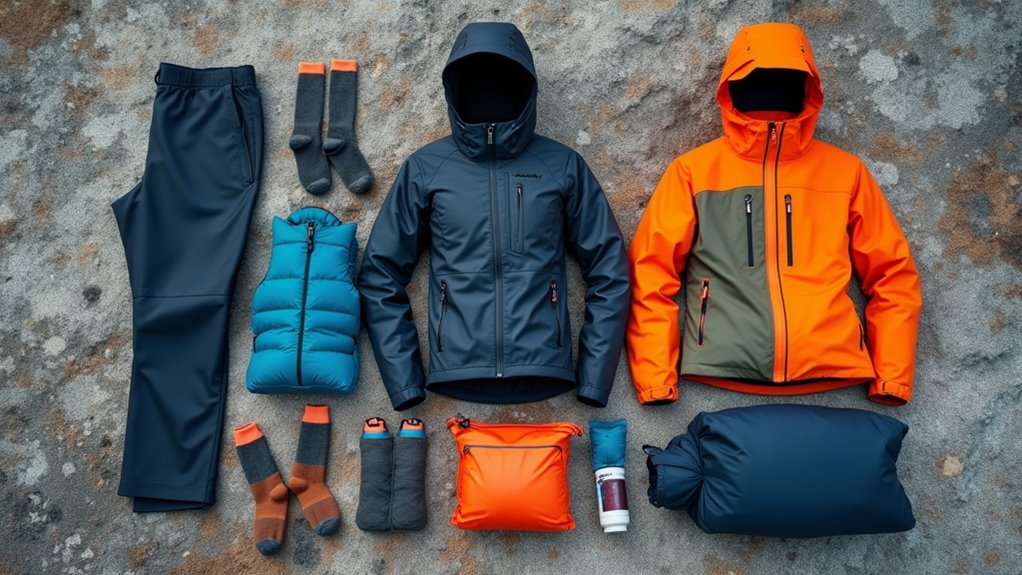
While medical supplies protect you from injury consequences, the right clothing system prevents many emergencies from happening in the first place. You’ll need three distinct layers that work together to regulate your body temperature and manage moisture in changing backcountry conditions.
Your base layer should wick sweat away from your skin using merino wool or synthetic materials—never cotton, which stays wet and cold.
The insulating middle layer traps warm air close to your body through fleece, down, or synthetic fill.
Your outer shell blocks wind and rain while allowing moisture to escape.
This system lets you add or remove layers as temperatures and activity levels change throughout your trip. Pack these clothing essentials in your hiking bag alongside other critical gear to ensure you’re prepared for any weather conditions you might encounter.
Even though you’ve carefully selected each piece of gear, discovering that your tent’s zipper jams or your stove won’t light becomes a serious problem when you’re miles from civilization.
Set up your tent in your backyard to check for missing stakes, broken zippers, or fabric tears. Fire up your camp stove and cook a simple meal to verify all connections work properly. Test your water filter with tap water and confirm your headlamp batteries provide adequate brightness.
Check your sleeping bag’s zipper and inspect your backpack’s straps for wear. Don’t forget to test electronic devices like GPS units or emergency beacons.
This home testing saves money on replacing defective gear and prevents dangerous situations in remote locations. While testing your gear, also consider reviewing tick bite prevention strategies since backcountry camping often involves exposure to tick-infested areas.
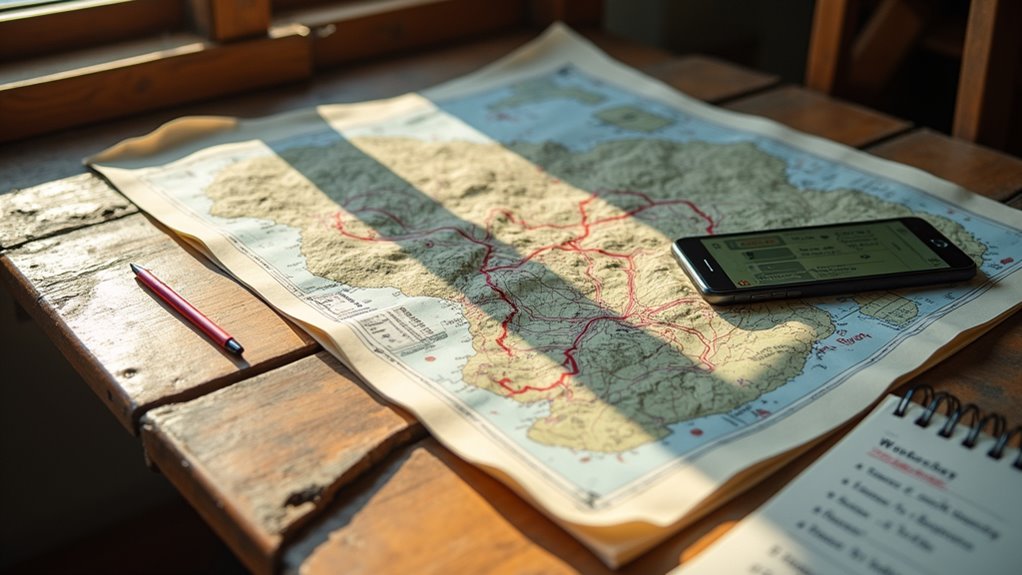
Before you disappear into the wilderness, you’ll need to share your detailed plans with someone reliable who can raise the alarm if you don’t return on schedule. Choose a trusted friend or family member who’ll actually follow through if something goes wrong.
Provide them with specifics they’ll need to help search and rescue teams locate you quickly:
Don’t just text “going camping” and disappear. Write everything down or email the details. This simple step costs nothing but could save your life if things go sideways out there. As a single mother, establishing this communication protocol becomes even more critical since you’ll be managing both your own safety and potentially serving as the primary caregiver for your children upon return.
Since emergencies can strike without warning in the backcountry, you’ll want to master essential survival skills before your boots hit the trail. Start with fire-building using matches, lighters, and primitive methods like flint and steel.
Practice creating shelter from natural materials – lean-tos, debris huts, and tarp configurations you can build quickly in bad weather.
Learn basic first aid for cuts, sprains, and hypothermia. Know how to purify water using boiling, tablets, or portable filters.
Study basic navigation with map and compass since GPS devices can fail.
Practice these skills in your backyard or local parks before heading out. YouTube tutorials and library books cost nothing but provide invaluable knowledge.
Consider taking an affordable wilderness survival course through community colleges or outdoor recreation centers.
Remember that these wilderness skills will serve you well whether you’re on a family camping trip or a solo backcountry expedition.
You’ll discover that proper preparation truly makes the difference between a memorable adventure and a dangerous ordeal. Don’t let anyone convince you that “winging it” builds character – that’s just reckless thinking that puts you at risk. When you’ve checked every item off this list, you’re not being overly cautious; you’re being smart. Your wallet and your safety will thank you when you’re confidently enjoying the wilderness instead of scrambling for solutions.